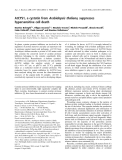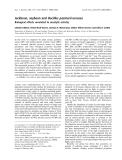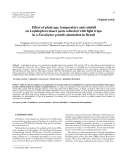
Plant and insect
-
Alternative strategies are needed in pest management to protect crops from pests. Occurrence of epiphytic lactic acid bacteria (LAB) on crop plants, especially on sites that are selected by pests, may be associated with host selection by insects. We carried out laboratory investigations as well as screen house and field experiments to understand whether epiphytic LAB occur at oviposition sites of agricultural and horticultural crops, probably modulating pest abundance by attraction or repulsion. The diversity of such epiphytic LAB associated with insect oviposition sites is discussed.
 15p
15p  nguaconbaynhay5
nguaconbaynhay5
 16-05-2020
16-05-2020
 17
17
 3
3
 Download
Download
-
The thesis studies the composition and density of insect pests and insects that mainly catch on tea, the ability to control pests of some major prey insects, the impact of some ecological factors on pests , the main prey of insects and their relationship, building credible references to sustainable farming areas of integrated tea pest management.
 27p
27p  xacxuoc4321
xacxuoc4321
 11-07-2019
11-07-2019
 49
49
 3
3
 Download
Download
-
Yellow stem borer has been identified as a major insect pest of deepwater rice, causing severe yield losses. Bt gene(s) from Bacillus thuringiensis have been proven very effective in pest resistance program. The use of transgenic plants expressing Bt gene(s) is now occupied effective approach to control insect infestation. We have successfully introduced a synthetic cryIA(b) gene into embryogenic calli of a deepwater indica rice variety, Vaidehi, by using the biolistic method of transformation.
 6p
6p  zingzing09
zingzing09
 24-04-2013
24-04-2013
 54
54
 1
1
 Download
Download
-
Insect pests and pathogens (fungi, bacteria and viruses) are responsible for severe crop losses. Insects feed directly on the plant tissues, while the pathogens lead to damage or death of the plant. Plants have evolved a certain degree of resistance through the production of defence compounds, which may be aproteic, e.g. antibiotics, alkaloids, terpenes, cyanogenic glucosides or proteic, e.g. chitinases,b-1,3-glu-canases, lectins, arcelins, vicilins, systemins and enzyme inhibitors.
 16p
16p  research12
research12
 23-04-2013
23-04-2013
 44
44
 3
3
 Download
Download
-
Báo cáo khoa học: AtCYS1, a cystatin from Arabidopsis thaliana, suppresses hypersensitive cell death
In plants, cysteine protease inhibitors are involved in the regulation of protein turnover and play an important role in resistance against insects and pathogens. AtCYS1from Arabidopsis thalianaencodes a protein of 102 amino acids that contains the conserved motif of cysteine protease inhibitors belonging to the cystatin superfamily (Gln-Val-Val-Ala-Gly). Recombinant A. thaliana cystatin-1 (AtCYS1) was expressed in Escherichia coliand purified.
 12p
12p  fptmusic
fptmusic
 16-04-2013
16-04-2013
 25
25
 3
3
 Download
Download
-
In this work we compared two plant ureases, jackbean urease (JBU) and embryo-specific soybean urease (SBU) and a bacterial (Bacillus pasteurii) urease, for kinetic parameters and other biological properties described recently for ureases that are independent of the ureolytic activity. The insecticidal effect of ureases was investigated in feedingtrials with the cotton sucker bug,Dysdercus peruvi-anus (Hemiptera) as an insect model. Contrastingwith B. pasteuriiurease (PBU), both plant ureases presented potent insecticidal activity, with LD50 values of 0.017% (w/w) and 0.
 7p
7p  dell39
dell39
 03-04-2013
03-04-2013
 43
43
 2
2
 Download
Download
-
The defensive function of the glucosinolate–myrosinase system in plants of the order Capparales results from the formation of isothiocyanates when glucosinolates are hydrolysed by myrosinases upon tissue damage. In some glucosinolate-containing plant species, as well as in the insect herbivore Pieris rapae, protein factors alter the outcome of myrosinase-catalysed glu-cosinolate hydrolysis, leading to the formation of products other than isothiocyanates.
 15p
15p  inspiron33
inspiron33
 26-03-2013
26-03-2013
 49
49
 5
5
 Download
Download
-
A phylogenetic analysis of more than 350 multicopper oxidases (MCOs) from fungi, insects, plants, and bacteria provided the basis for a refined classification of this enzyme family into laccasessensu stricto (basidiomyc-etous and ascomycetous), insect laccases, fungal pigment MCOs, fungal ferroxidases, ascorbate oxidases, plant laccase-like MCOs, and bilirubin oxidases.
 19p
19p  inspiron33
inspiron33
 26-03-2013
26-03-2013
 52
52
 4
4
 Download
Download
-
Plants are continuously challenged by a variety of abiotic and biotic cues. To deter feeding insects, nematodes and fungal and bacterial pathogens, plants have evolved a plethora of defence strategies. A central player in many of these defence responses is jasmonic acid.
 16p
16p  vinaphone15
vinaphone15
 25-02-2013
25-02-2013
 52
52
 2
2
 Download
Download
-
The digestive tract of lepidopteran insects is extremely alkaline. In the pres-ent work, molecular adaptation of amylolytic enzymes to this environment was investigated in the flour moth Ephestia kuehniella, an important stored-product pest. Three digestivea-amylases [Ephestia kuehniellaa-amy-lase isoenzymes 1–3 (EkAmy1–3)] with an alkaline pH optimum were puri-fied from larvae and biochemically characterized.
 16p
16p  viettel02
viettel02
 22-02-2013
22-02-2013
 44
44
 2
2
 Download
Download
-
Tuyển tập các báo cáo nghiên cứu về lâm nghiệp được đăng trên tạp chí lâm nghiệp Original article đề tài: "Effect of plant age, temperature and rainfall on Lepidoptera insect pests collected with light traps in a Eucalyptus grandis plantation in Brazil"
 6p
6p  toshiba5
toshiba5
 19-09-2011
19-09-2011
 57
57
 4
4
 Download
Download
CHỦ ĐỀ BẠN MUỐN TÌM
























